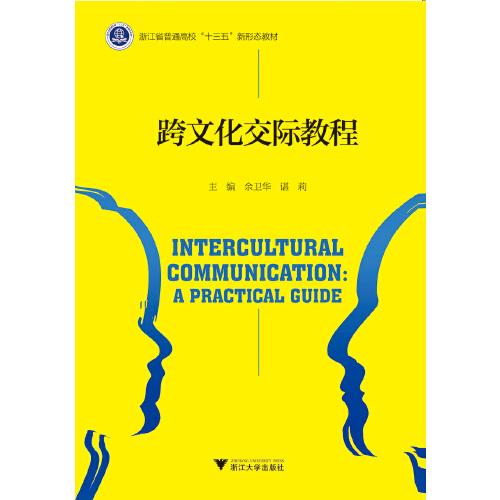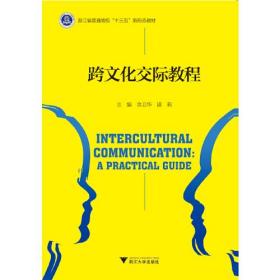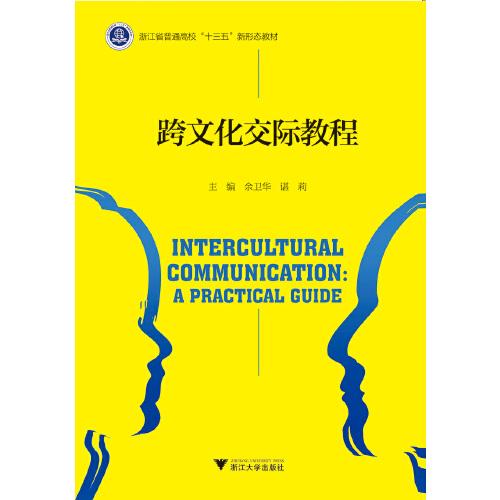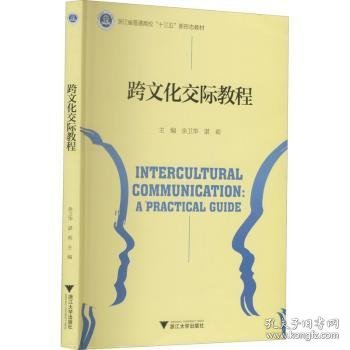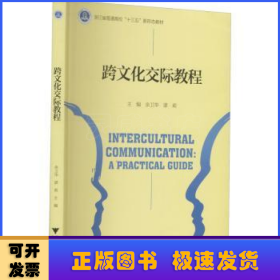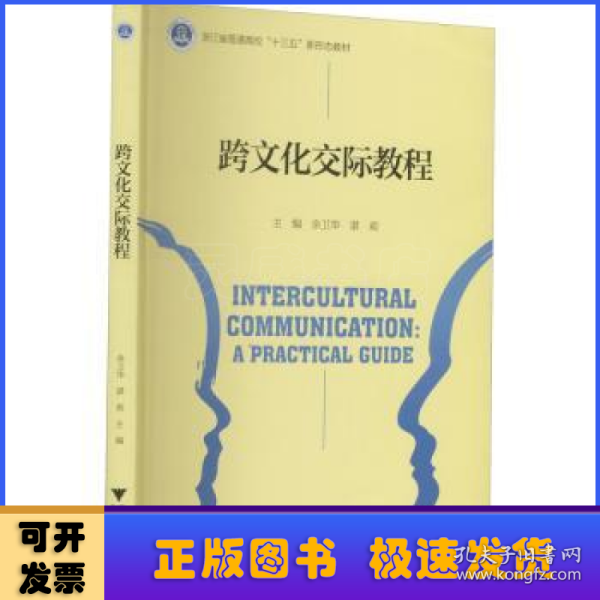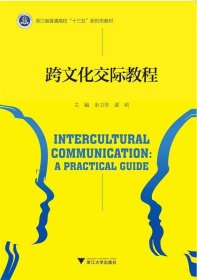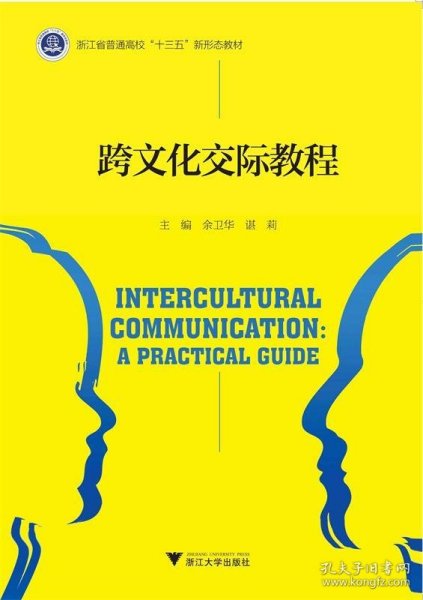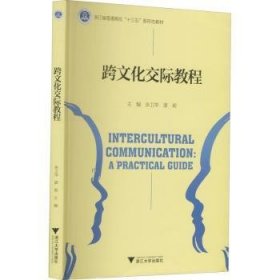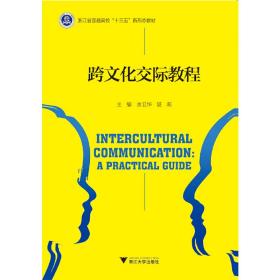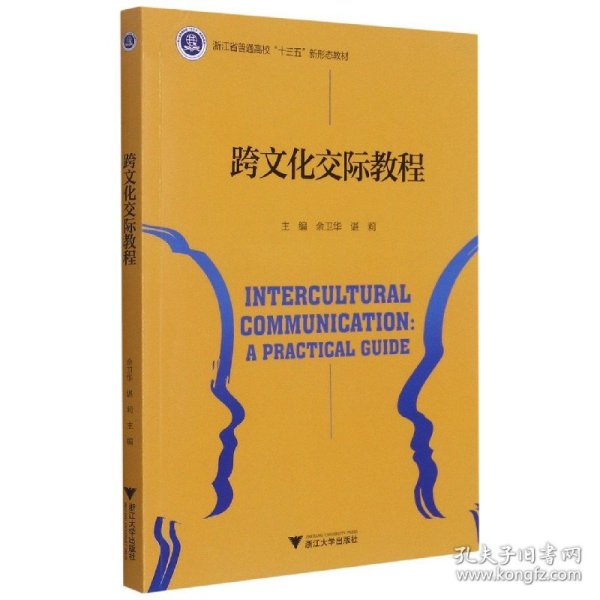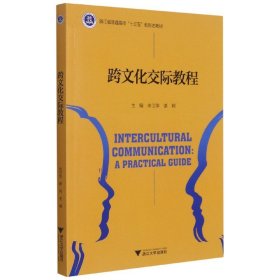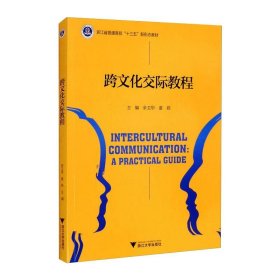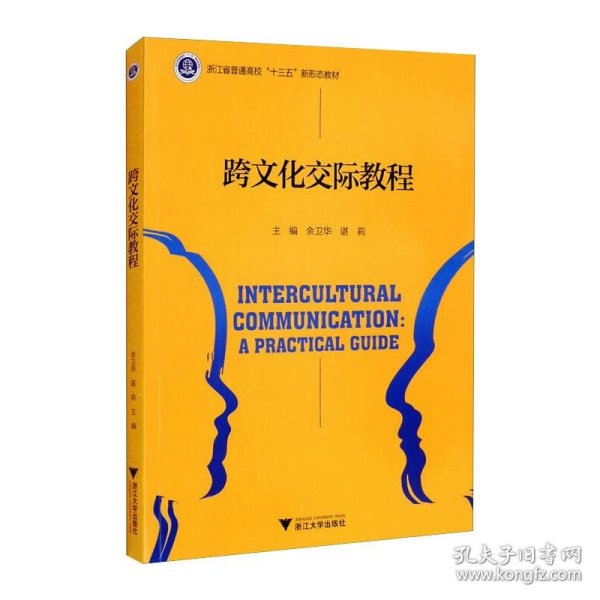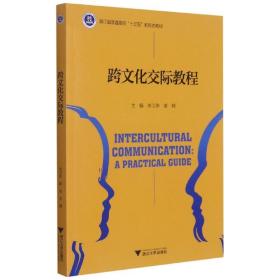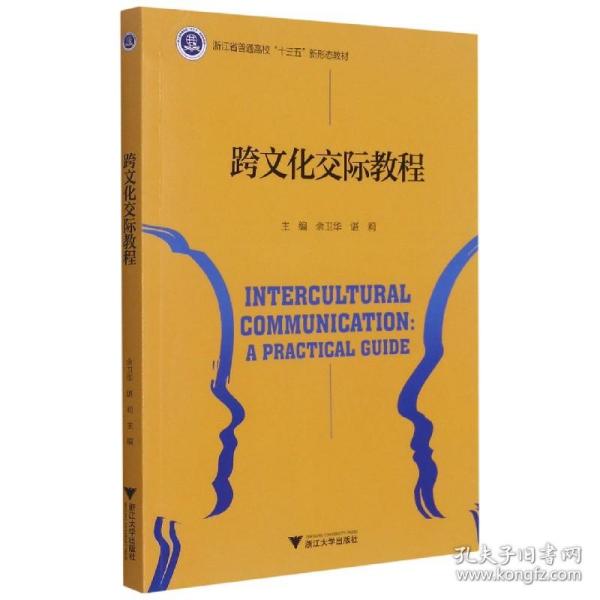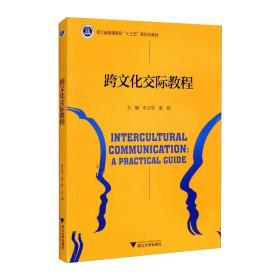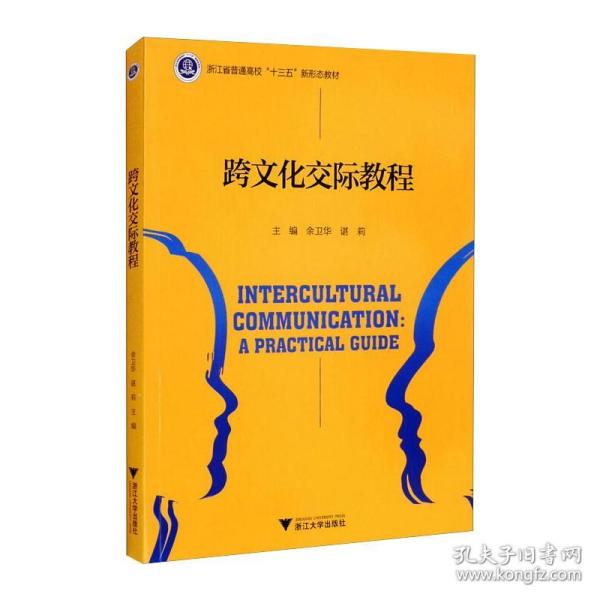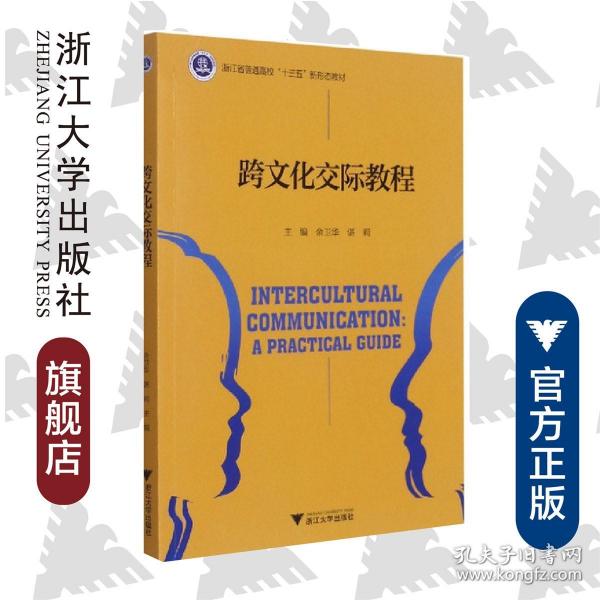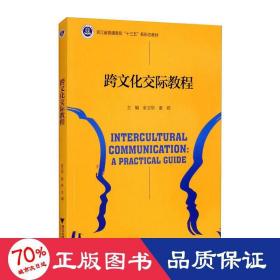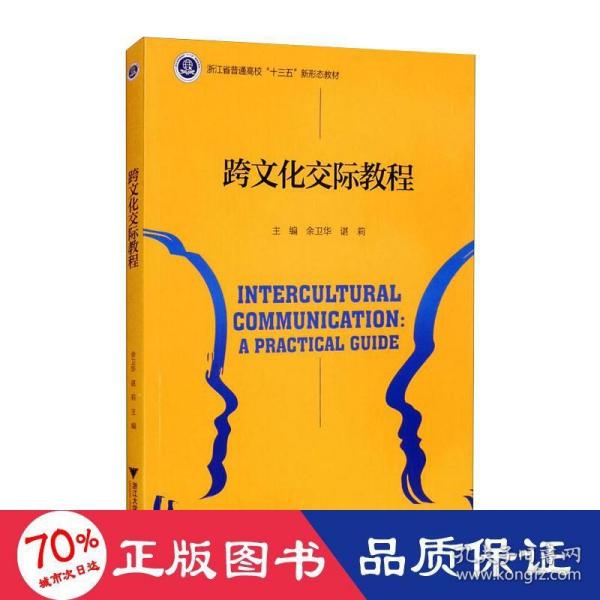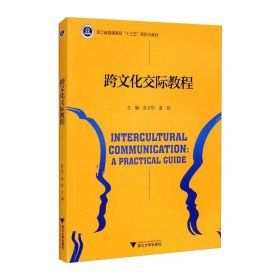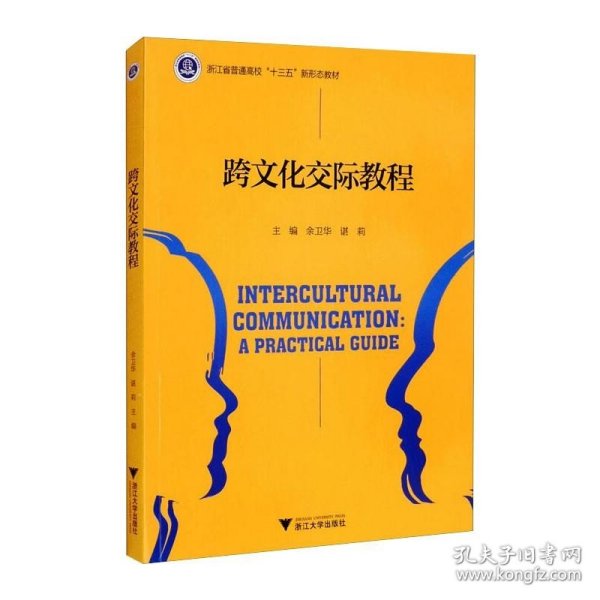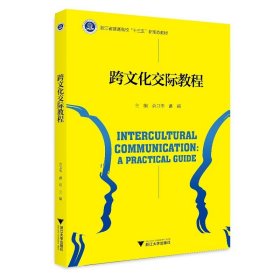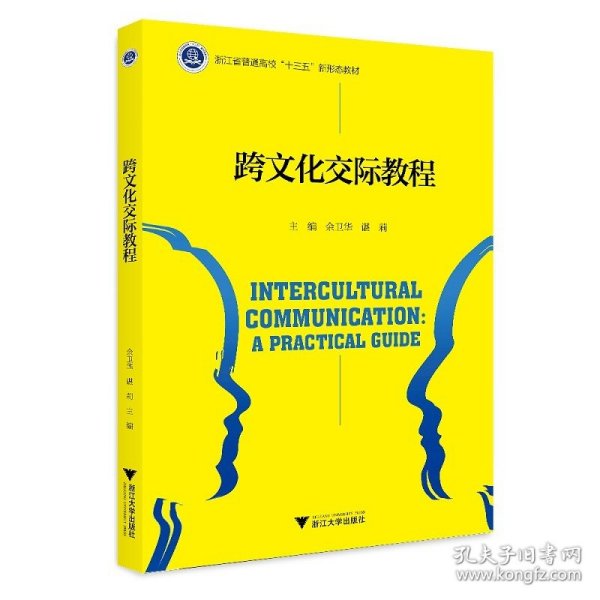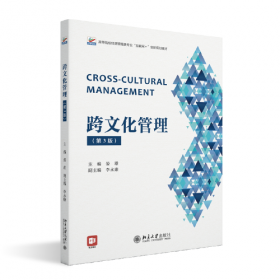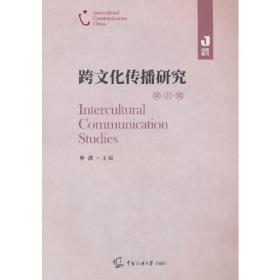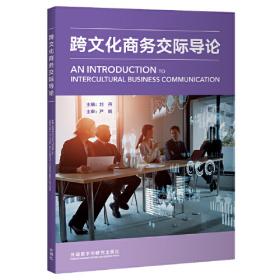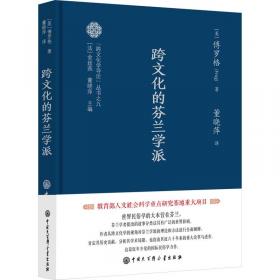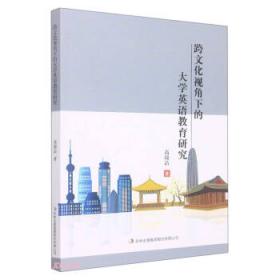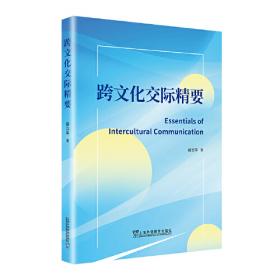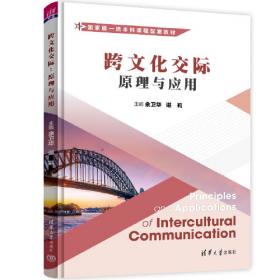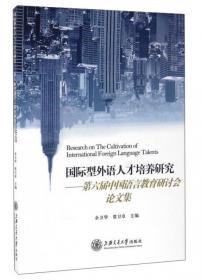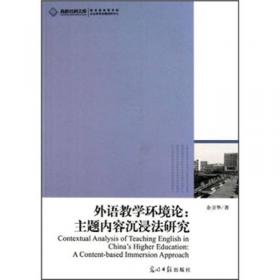跨文化交际教程
出版时间:
2019-02
版次:
1
ISBN:
9787308181778
定价:
50.00
装帧:
其他
开本:
大32开
纸张:
胶版纸
85人买过
-
Chapter 1 Brief Introduction to Intercultural Communication
1.1 Culture as Intercultural Communication
1.1.1 Two Types of Culture
1.1.2 Five Dimensions of Culture
1.1.3 Characteristics of Culture
1.1.4 Definition of Intercultural Communication
1.2 Approaches to Intercultural Communication
1.2.1 Five Elements in Communication Process
1.2.2 Tips on How to Communicate Effectively
Chapter 2 Verbal and Nonverbal Communication
2.1 Introduction to Verbal Communication
2.1.1 Role of Language in Verbal Communication
2.1.2 Receptive and Productive Language Skills
2.1.3 Need for Using Bias-free Language
2.1.4 Types of Verbal Communication
2.2 Introduction to Nonverbal Communication
2.2.1 Definition of Nonverbal Communication
2.2.2 Major Types and Main Features of Nonverbal Communication
2.3 Major Functions of Nonverbal Communication
2.3.1 Nonverbal Communication Conveys Meaning
2.3.2 Nonverbal Communication Regulates Conversational Flow
2.3.3 Nonverbal Communication Affects Relationships
2.3.4 Nonverbal Communication Expresses Our Identities
2.4 Deception and Nonverbal Communication Competence
2.4.1 Concept and Misinterpretation of Deception
2.4.2 Deception Detecting Abilities and Bias
2.4.3 Misconception of Nonverbal Leakage
2.4.4 Typical Giveaway Signs of Deception
2.5 Getting Competent
2.5.1 Guidelines to Improve Nonverbal Competence
2.5.2 Applicable Advices in Specific Channels
Complementary 1 : Scripts of Julian Treasure's TED Lecture---How to Speak So that People Want to Listen
Complementary 2: Scripts of Amy Cuddy's TED Lecture--Your Body Language May Shape Who You Are
Chapter 3 Communicative Competence and Intercultural Communication Competence
3.1 Communicating Under Different Cultural Contexts
3.1.1 Differences in Greetings
3.1.2 Differences in Approval and Disapproval Movements
Complementary: Signs Not to Use Casually Abroad
3.2 From Communicative Competence to Intercultural Communication Competence
3.2.1 Framework for Communicative Competence
3.2.2 Concept of Communicative Competence
3.2.3 Concept of Transcultural Competence
3.2.4 Skills of Multilingual Communicators
3.2.5 Components of Intercultural Communication Competence
3.3 Case Study: Cultural Clashes in Japanese Story
3.4 A Recipe for Successful Intercultural Communication
3.4.1 A Heart Set
3.4.2 A Mindset
3.4.3 A Skill Set
3.4.4 Other Practical Approaches
3.5 Culture Shock
3.5.1 Five Phases of Culture Shock
3.5.2 Reverse Culture Shock
3.5.3 Outcomes of the Adjustment Phase
3.5.4 Transition Shock
Chapter 4 Stereotype and Prejudice
4.1 Stereotype and Prejudice: American Party
4.1.1 Definition of Stereotype
4.1.2 Types of Stereotype
4.1.3 Definition of Prejudice
4.1.4 Ways to Reduce Stereotypes and Prejudices
4.2 Gender Stereotype: Perfect Women
4.2.1 Definition of Gender Stereotype
4.2.2 Four Basic Kinds of Gender Stereotype
4.2.3 Stereotype Threat
4.2.4 Impact of Female Stereotype in Ancient China
4.2.5 Impact of Female Stereotype in Modern China
4.2.6 Tips for Reducing Gender Stereotype
4.3 Classism: The Poor vs. the Rich
4.3.1 Definition and Nature of Prejudice
4.3.2 Definition of Classism
4.3.3 Causes for Prejudice
4.4 Ethnic Prejudice: African Americans
4.4.1 Definition of Ethnic Group
4.4.2 Definition of Ethnic Prejudice
4.4.3 Effects of Prejudice
4.4.4 Strategies for Reducing Ethnic Prejudice
Chapter 5 Chinese Culture
5.1 Yellow Civilization: The Loess Plateau
5.1.1 The Loess and the Loess Plateau
5.1.2 Agricultural Civilization and Ethnic Integration
5.1.3 Mellow Civilization and National Spirit
5.2 Spiritual Origin: Confucianism
5.2.1 Confucianism, Confucius, and Confucian Classics
5.2.2 Confucianism in the East
5.2.3 Confucianism in the West
5.3 Chinese Education
5.3.1 Confucian Education
5.3.2 Chinese School System: 1922-1932
5.3.3 Higher Education Reform After the "Cultural Revolution"
5.4 Yuanming Yuan
5.4.1 Construction of Yuanming Yuan
5.4.2 Destruction ofYuanming Yuan
5.4.3 Mourn for Yuanming Yuan
5.5 Chinese Festivals
5.5.1 Spring Festival
5.5.2 Lantern Festival
5.5.3 Qingming Festival
5.5.4 Dragon Boat Festival
5.5.5 Double Seventh Festival
5.5.6 Mid-autumn Festival
5.5.7 Double Ninth Festival
5.5.8 Winter Solstice Festival
5.6 Chinese Cuisine
5.6.1 Chinese Regional Cuisines
5.6.2 Types of Chinese Cuisines
5.6.3 Relation to Chinese Art
5.7 Chinese Costume--Qipao
5.7.1 History
5.7.2 Origin
5.7.3 Variation Through History
Chapter 6 Western Culture
6.1 Blue Civilization: Ancient Greece
6.1.1 Cradle of Blue Civilization
6.1.2 History of Ancient Greece
6.1.3 Legacies of Ancient Greece
6.2 Religious Origin: Christianity
6.2.1 Birth of Christianity
6.2.2 Spread and Triumph of Christianity
6.2.3 Impacts of Christianity
6.3 American Education
6.3.1 American Educational History
6.3.2 American Educational System
6.3.3 American Educational Hallmarks
6.4 Chateau de Versailles
6.4.1 Western Garden Art Before Chateau de Versailles
6.4.2 History of Chateau de Versailles
6.4.3 Layout and Features of Chateau de Versailles
6.5 Western Festival---Christmas
6.5.1 Customs and Traditions
6.5.2 Decorations
6.5.3 Traditional Cuisine
6.5.4 Cards
6.5.5 Gift Giving
6.6 Western Cuisine
6.6.1 Traditional Cuisine
6.6.2 American Cuisine
6.7 Western Costume--Scottish Kilt
6.7.1 History
6.7.2 Design and Construction
6.7.3 Fabrics
6.7.4 Setts
6.7.5 Accessories
6.7.6 Contemporary Designs
Chapter 7 Globalization
7.1 Overview of Globalization
7.1.1 Definition of Globalization
7.1.2 Three-tiered Conception of Globalization
7.2 Economic Globalization
7.2.1 Definition of Economic Globalization
7.2.2 Effects of Economic Globalization
7.3 Political Globalization
7.3.1 Definition of Political Globalization
7.3.2 Impact of Political Globalization
7.4 Cultural Globalization
7.4.1 Definition of Cultural Globalization
7.4.2 Two Perspectives of Cultural Globalization
7.4.3 Impact of Cultural Globalization
7.5 Anti-globalization Movement
7.5.1 Definition of Anti-globalization Movement
7.5.2 Reasons of Anti-globalization Movement
7.5.3 Influence of Anti-globalization Movement
Chapter 8 Social Identity
8.1 Sports Group: Basketball Game
8.1.1 Definition of Social Identity
8.1.2 Definition of Self-concept
8.1.3 Definition of Self-esteem
8.1.4 Henry Tajfel and His Social Identity Theory
8.1.5 An Example of Social Identity
8.2 Nerdy Guy: Sheldon Cooper
8.2.1 Definition of Self-esteem
8.2.2 Tajfel and His Minimal Group Study
8.2.3 Definition of Positive Distinctiveness
8.2.4 Strategies to Achieve Positive Distinctiveness
8.3 Intergroup Behavior: Immigrants to the US
8.3.1 Interpersonal Behavior and Intergroup Behavior
8.3.2 Definition of Intergroup Conflict
8.3.3 Realistic Conflict Theory
8.3.4 Definition Of Superordinate Goals
8.3.5 Muzafer Sherifand His Robbers Cave Experiment
8.4 Social Identity and Social Comparison
8.4.1 Definition of Social Group
8.4.2 Definition of Intergroup Behavior
8.4.3 Understanding of Social Identity
8.4.4 Variables Influencing Intergroup Differentiation
8.4.5 Social and Instrumental/Realistic Competition
Chapter 9 Global Citizenship
9.1 Global Citizenship
9.1.1 Definition of Global Citizenship
9.1.2 Origin of Global Citizenship
9.1.3 Global Citizenship in Other Context
9.1.4 Concept of"Glocalization"
9.2 Global Citizenship Education
9.2.1 Definition of Global Citizenship Education
9.2.2 Common Perspectives on GCE
9.2.3 Pedagogical Features of GCE
9.3 Themes, Outlooks, and Skills for Global Citizenship
9.3.1 Core Themes of Global Citizenship
9.3.2 Outlooks of Global Citizenship
9.3.3 Skills Needed for Global Citizenship
Main References
Appendices
-
目录:
Chapter 1 Brief Introduction to Intercultural Communication
1.1 Culture as Intercultural Communication
1.1.1 Two Types of Culture
1.1.2 Five Dimensions of Culture
1.1.3 Characteristics of Culture
1.1.4 Definition of Intercultural Communication
1.2 Approaches to Intercultural Communication
1.2.1 Five Elements in Communication Process
1.2.2 Tips on How to Communicate Effectively
Chapter 2 Verbal and Nonverbal Communication
2.1 Introduction to Verbal Communication
2.1.1 Role of Language in Verbal Communication
2.1.2 Receptive and Productive Language Skills
2.1.3 Need for Using Bias-free Language
2.1.4 Types of Verbal Communication
2.2 Introduction to Nonverbal Communication
2.2.1 Definition of Nonverbal Communication
2.2.2 Major Types and Main Features of Nonverbal Communication
2.3 Major Functions of Nonverbal Communication
2.3.1 Nonverbal Communication Conveys Meaning
2.3.2 Nonverbal Communication Regulates Conversational Flow
2.3.3 Nonverbal Communication Affects Relationships
2.3.4 Nonverbal Communication Expresses Our Identities
2.4 Deception and Nonverbal Communication Competence
2.4.1 Concept and Misinterpretation of Deception
2.4.2 Deception Detecting Abilities and Bias
2.4.3 Misconception of Nonverbal Leakage
2.4.4 Typical Giveaway Signs of Deception
2.5 Getting Competent
2.5.1 Guidelines to Improve Nonverbal Competence
2.5.2 Applicable Advices in Specific Channels
Complementary 1 : Scripts of Julian Treasure's TED Lecture---How to Speak So that People Want to Listen
Complementary 2: Scripts of Amy Cuddy's TED Lecture--Your Body Language May Shape Who You Are
Chapter 3 Communicative Competence and Intercultural Communication Competence
3.1 Communicating Under Different Cultural Contexts
3.1.1 Differences in Greetings
3.1.2 Differences in Approval and Disapproval Movements
Complementary: Signs Not to Use Casually Abroad
3.2 From Communicative Competence to Intercultural Communication Competence
3.2.1 Framework for Communicative Competence
3.2.2 Concept of Communicative Competence
3.2.3 Concept of Transcultural Competence
3.2.4 Skills of Multilingual Communicators
3.2.5 Components of Intercultural Communication Competence
3.3 Case Study: Cultural Clashes in Japanese Story
3.4 A Recipe for Successful Intercultural Communication
3.4.1 A Heart Set
3.4.2 A Mindset
3.4.3 A Skill Set
3.4.4 Other Practical Approaches
3.5 Culture Shock
3.5.1 Five Phases of Culture Shock
3.5.2 Reverse Culture Shock
3.5.3 Outcomes of the Adjustment Phase
3.5.4 Transition Shock
Chapter 4 Stereotype and Prejudice
4.1 Stereotype and Prejudice: American Party
4.1.1 Definition of Stereotype
4.1.2 Types of Stereotype
4.1.3 Definition of Prejudice
4.1.4 Ways to Reduce Stereotypes and Prejudices
4.2 Gender Stereotype: Perfect Women
4.2.1 Definition of Gender Stereotype
4.2.2 Four Basic Kinds of Gender Stereotype
4.2.3 Stereotype Threat
4.2.4 Impact of Female Stereotype in Ancient China
4.2.5 Impact of Female Stereotype in Modern China
4.2.6 Tips for Reducing Gender Stereotype
4.3 Classism: The Poor vs. the Rich
4.3.1 Definition and Nature of Prejudice
4.3.2 Definition of Classism
4.3.3 Causes for Prejudice
4.4 Ethnic Prejudice: African Americans
4.4.1 Definition of Ethnic Group
4.4.2 Definition of Ethnic Prejudice
4.4.3 Effects of Prejudice
4.4.4 Strategies for Reducing Ethnic Prejudice
Chapter 5 Chinese Culture
5.1 Yellow Civilization: The Loess Plateau
5.1.1 The Loess and the Loess Plateau
5.1.2 Agricultural Civilization and Ethnic Integration
5.1.3 Mellow Civilization and National Spirit
5.2 Spiritual Origin: Confucianism
5.2.1 Confucianism, Confucius, and Confucian Classics
5.2.2 Confucianism in the East
5.2.3 Confucianism in the West
5.3 Chinese Education
5.3.1 Confucian Education
5.3.2 Chinese School System: 1922-1932
5.3.3 Higher Education Reform After the "Cultural Revolution"
5.4 Yuanming Yuan
5.4.1 Construction of Yuanming Yuan
5.4.2 Destruction ofYuanming Yuan
5.4.3 Mourn for Yuanming Yuan
5.5 Chinese Festivals
5.5.1 Spring Festival
5.5.2 Lantern Festival
5.5.3 Qingming Festival
5.5.4 Dragon Boat Festival
5.5.5 Double Seventh Festival
5.5.6 Mid-autumn Festival
5.5.7 Double Ninth Festival
5.5.8 Winter Solstice Festival
5.6 Chinese Cuisine
5.6.1 Chinese Regional Cuisines
5.6.2 Types of Chinese Cuisines
5.6.3 Relation to Chinese Art
5.7 Chinese Costume--Qipao
5.7.1 History
5.7.2 Origin
5.7.3 Variation Through History
Chapter 6 Western Culture
6.1 Blue Civilization: Ancient Greece
6.1.1 Cradle of Blue Civilization
6.1.2 History of Ancient Greece
6.1.3 Legacies of Ancient Greece
6.2 Religious Origin: Christianity
6.2.1 Birth of Christianity
6.2.2 Spread and Triumph of Christianity
6.2.3 Impacts of Christianity
6.3 American Education
6.3.1 American Educational History
6.3.2 American Educational System
6.3.3 American Educational Hallmarks
6.4 Chateau de Versailles
6.4.1 Western Garden Art Before Chateau de Versailles
6.4.2 History of Chateau de Versailles
6.4.3 Layout and Features of Chateau de Versailles
6.5 Western Festival---Christmas
6.5.1 Customs and Traditions
6.5.2 Decorations
6.5.3 Traditional Cuisine
6.5.4 Cards
6.5.5 Gift Giving
6.6 Western Cuisine
6.6.1 Traditional Cuisine
6.6.2 American Cuisine
6.7 Western Costume--Scottish Kilt
6.7.1 History
6.7.2 Design and Construction
6.7.3 Fabrics
6.7.4 Setts
6.7.5 Accessories
6.7.6 Contemporary Designs
Chapter 7 Globalization
7.1 Overview of Globalization
7.1.1 Definition of Globalization
7.1.2 Three-tiered Conception of Globalization
7.2 Economic Globalization
7.2.1 Definition of Economic Globalization
7.2.2 Effects of Economic Globalization
7.3 Political Globalization
7.3.1 Definition of Political Globalization
7.3.2 Impact of Political Globalization
7.4 Cultural Globalization
7.4.1 Definition of Cultural Globalization
7.4.2 Two Perspectives of Cultural Globalization
7.4.3 Impact of Cultural Globalization
7.5 Anti-globalization Movement
7.5.1 Definition of Anti-globalization Movement
7.5.2 Reasons of Anti-globalization Movement
7.5.3 Influence of Anti-globalization Movement
Chapter 8 Social Identity
8.1 Sports Group: Basketball Game
8.1.1 Definition of Social Identity
8.1.2 Definition of Self-concept
8.1.3 Definition of Self-esteem
8.1.4 Henry Tajfel and His Social Identity Theory
8.1.5 An Example of Social Identity
8.2 Nerdy Guy: Sheldon Cooper
8.2.1 Definition of Self-esteem
8.2.2 Tajfel and His Minimal Group Study
8.2.3 Definition of Positive Distinctiveness
8.2.4 Strategies to Achieve Positive Distinctiveness
8.3 Intergroup Behavior: Immigrants to the US
8.3.1 Interpersonal Behavior and Intergroup Behavior
8.3.2 Definition of Intergroup Conflict
8.3.3 Realistic Conflict Theory
8.3.4 Definition Of Superordinate Goals
8.3.5 Muzafer Sherifand His Robbers Cave Experiment
8.4 Social Identity and Social Comparison
8.4.1 Definition of Social Group
8.4.2 Definition of Intergroup Behavior
8.4.3 Understanding of Social Identity
8.4.4 Variables Influencing Intergroup Differentiation
8.4.5 Social and Instrumental/Realistic Competition
Chapter 9 Global Citizenship
9.1 Global Citizenship
9.1.1 Definition of Global Citizenship
9.1.2 Origin of Global Citizenship
9.1.3 Global Citizenship in Other Context
9.1.4 Concept of"Glocalization"
9.2 Global Citizenship Education
9.2.1 Definition of Global Citizenship Education
9.2.2 Common Perspectives on GCE
9.2.3 Pedagogical Features of GCE
9.3 Themes, Outlooks, and Skills for Global Citizenship
9.3.1 Core Themes of Global Citizenship
9.3.2 Outlooks of Global Citizenship
9.3.3 Skills Needed for Global Citizenship
Main References
Appendices
查看详情
-
全新
山东省泰安市
平均发货22小时
成功完成率87.04%
-
全新
浙江省嘉兴市
平均发货10小时
成功完成率90.89%
-
全新
上海市黄浦区
平均发货10小时
成功完成率94.33%
-
全新
北京市丰台区
平均发货7小时
成功完成率91.32%
-
全新
广东省广州市
平均发货9小时
成功完成率86.4%
-
全新
江苏省宿迁市
平均发货21小时
成功完成率88.33%
-
全新
北京市通州区
平均发货9小时
成功完成率88.84%
-
全新
北京市通州区
平均发货9小时
成功完成率94.15%
-
跨文化交际教程
正版库存一手书,品相视出版时间长短而定,自然成色,可开电子发票,图片由软件自动采集,以书名为准,不以图片不符售后!
全新
山东省泰安市
平均发货8小时
成功完成率93.02%
-
全新
山东省泰安市
平均发货15小时
成功完成率93.81%
-
全新
北京市房山区
平均发货8小时
成功完成率87.76%
-
全新
上海市浦东新区
平均发货21小时
成功完成率87.41%
-
全新
广东省广州市
平均发货15小时
成功完成率88.79%
-
全新
广东省广州市
平均发货18小时
成功完成率89.38%
-
全新
北京市朝阳区
平均发货17小时
成功完成率72.78%
-
全新
北京市朝阳区
平均发货30小时
成功完成率63.64%
-
全新
北京市海淀区
平均发货17小时
成功完成率85.08%
-
全新
四川省成都市
平均发货22小时
成功完成率88.79%
-
全新
北京市海淀区
平均发货13小时
成功完成率91.76%
-
全新
广东省广州市
平均发货16小时
成功完成率90.03%
-
全新
广东省广州市
平均发货23小时
成功完成率85.17%
-
全新
广东省广州市
平均发货18小时
成功完成率88.82%
-
全新
广东省广州市
平均发货23小时
成功完成率85.17%
-
全新
湖北省武汉市
平均发货24小时
成功完成率90.66%
-
全新
广东省广州市
平均发货18小时
成功完成率86.69%
-
全新
浙江省嘉兴市
平均发货9小时
成功完成率94.16%
-
全新
浙江省嘉兴市
平均发货13小时
成功完成率94.26%
-
全新
湖北省武汉市
平均发货20小时
成功完成率91.3%
-
全新
北京市西城区
平均发货18小时
成功完成率89.83%
-
全新
山东省潍坊市
平均发货16小时
成功完成率79.55%
-
全新
北京市东城区
平均发货10小时
成功完成率95.42%
-
全新
广东省广州市
平均发货18小时
成功完成率86.69%
-
全新
浙江省杭州市
平均发货20小时
成功完成率90.66%
-
全新
北京市西城区
平均发货14小时
成功完成率92.49%
-
全新
天津市河东区
平均发货24小时
成功完成率89.82%
-
全新
北京市通州区
平均发货9小时
成功完成率88.84%
-
全新
湖北省武汉市
平均发货23小时
成功完成率83.9%
-
全新
江苏省无锡市
平均发货15小时
成功完成率93.81%
-
全新
天津市西青区
平均发货14小时
成功完成率90.25%
-
全新
广东省广州市
平均发货7小时
成功完成率94.72%
-
全新
北京市丰台区
平均发货27小时
成功完成率86.83%
-
全新
广东省广州市
平均发货7小时
成功完成率88.83%
-
全新
湖北省武汉市
平均发货22小时
成功完成率78.35%
-
全新
江苏省南京市
平均发货7小时
成功完成率95.3%
-
全新
江苏省南京市
平均发货14小时
成功完成率83.03%
-
全新
江苏省南京市
平均发货6小时
成功完成率98.26%
-
跨文化交际教程
全新正版书籍,假一罚十(图片为标准图,仅供参考。以标题为准,不了解的可以询问客服。)
全新
北京市朝阳区
平均发货14小时
成功完成率95.36%
-
全新
北京市朝阳区
平均发货13小时
成功完成率93.04%
-
2024年 印刷
印次: 4
全新
-
全新
湖南省益阳市
平均发货45小时
成功完成率90.37%

 占位居中
占位居中

